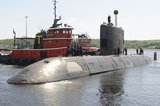RDEL launches first two Indian OPVs
Reliance Defence and Engineering Limited (RDEL) has launched the first two Naval Offshore Patrol Vessels (OPVs) for the Indian Navy at its shipyard in Pipavav, Gujarat, India, the company announced on 25 July.
The OPVs are the first of five ships being constructed by RDEL under the P-21 project of the Indian Navy.
The five OPVs are armed with a 76mm Super Rapid Gun Mount system along with two 30mm AK-630 guns, which provide medium range and short range offensive and defensive capabilities. The armament is remotely controlled through an electronic fire control system.
The vessels are powered by 20,000KW diesel engine-driven propulsion systems and can travel at speeds up to 25 knots. Ship operations are controlled by an intelligent integrated platform management system which has interfaces for all operational activities on-board the ship.
RDEL is also engaged in the construction of one training ship and 14 fast patrol vessels for the Indian Coast Guard.
More from Naval Warfare
-
![How will SAFE shape naval procurement for Canada and its highest-receiving members?]()
How will SAFE shape naval procurement for Canada and its highest-receiving members?
Canada’s inclusion on the EU’s Security Action for Europe initiative is set to enhance the country’s defence procurement strategy with important implications for some of its naval programmes, while Poland and Romania have also secured significant SAFE funding.
-
![Thales wins DE&S contract for portable autonomous command centres]()
Thales wins DE&S contract for portable autonomous command centres
The agreement to provide portable autonomous command centres to the UK Royal Navy will enhance the service’s Mine Counter Measure operations and further integrate autonomous and uncrewed systems into its fleet.
-
![US Navy to conduct an experimentation campaign with emerging tech in 2026 and 2027]()
US Navy to conduct an experimentation campaign with emerging tech in 2026 and 2027
The Technology Operational Experimentation Events will inform future requirements as the US Navy looks for innovative solutions across three key operational domains.





















